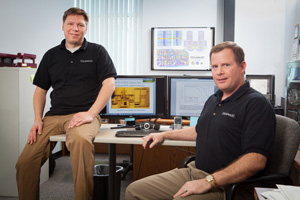- News
17 May 2016
NASA awards Ozark $754,000 to create SiC-based UV imager on a chip
The US National Aeronautics and Space Administration (NASA) has awarded $754,000 to Ozark Integrated Circuits Inc of Fayetteville, AR, USA (a fabless spin-off from the University of Arkansas that develops analog and mixed-signal ICs for remote sensing and actuation in extreme-temperatures and -radiation environments) to fabricate a silicon carbide (SiC)-based ultraviolet imager prototype for planetary exploration and Earth observation from space, among other applications.
Ozark IC (which designs semiconductors at the Arkansas Research and Technology Park) will develop a complex photo-detecting microchip that can operate in temperatures ranging from -200°C to +500°C (-330°F to +930°F).
"The uniqueness of our approach is the extreme responsiveness of our imager's sensor and our ability to integrate it with the readout electronics to turn the detector readings into images for a computer or spacecraft system," says Ozark IC's president & CEO Matt Francis. "NASA would be able to use the imager to observe areas on Earth from space as well as other objects in space."
The use of silicon carbide means that the imager can operate at low voltage over a very wide temperature range, making it suitable for planetary exploration that requires space-borne instruments capable of measuring light in the ultraviolet spectrum. Two examples are NASA's Discovery and New Horizons missions (which intend to image planets from orbit or on the surface) and those proposed for Venus (where the imager would need to operate at nearly 500°C).
 Picture:
Matt Francis (left) and Jim Holmes of Ozark.
Picture:
Matt Francis (left) and Jim Holmes of Ozark.
Francis and chief technology officer Jim Holmes have worked with University of Arkansas electrical engineering professor Alan Mantooth and computer science and engineering professor Jia Di over the last several years to perfect design procedures, tools, characterization and modeling approaches that enable them to design high-temperature electronics capable of operating at conditions well beyond 300°C.
Ozark IC will also use the integrated circuit packaging expertise and facilities of the University of Arkansas' High Density Electronics Research Center (HiDEC) at the research park.
The NASA Phase II contract came through the Small Business Innovation Research (SBIR) program, which allows federal agencies to stimulate technological innovation in the private sector by strengthening small businesses that meet federal R&D needs. The program is also intended to increase the commercial application of federally supported research results.
NASA awards Ozark $245,000 in phase 1 SBIR grants to design SiC-based ICs for Venus Rover
University of Arkansas wins extra $200,000 NSF grant to further develop high-temperature SiC ICs
Arkansas researchers design SiC-based ICs operable at over 350°C


